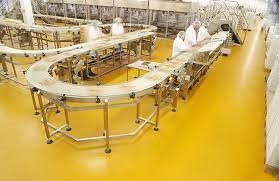
Food processing flooring is a crucial element of any food production facility. It plays a significant role in maintaining hygiene and ensuring the safety of food products. The type of flooring used in a food processing facility depends on various factors such as the type of food being produced, cleaning and sanitation procedure and the level of foot traffic.
One of the main requirements for food processing flooring is that it should be easy to clean and maintain. This is because food production facilities are prone to spills, stains and contamination from bacteria and other microorganisms. The flooring material should be non-porous, impermeable and resistant to chemicals used for cleaning and disinfection.
Another important consideration for food processing flooring is its ability to withstand heavy foot traffic. With workers constantly moving around the facility, the flooring should be durable and able to withstand the constant wear and tear. It should also have a non-slip surface to prevent accidents and injuries.
In addition to functionality, aesthetics also play a role in choosing food processing flooring. The flooring should be visually appealing and contribute to creating a clean and hygienic environment. This can boost employee morale and improve the overall image of the facility.
Why Choose Epoxy Flooring for Food Processing?
So why exactly is epoxy flooring a top choice for food processing facilities? Here are several reasons:
Durability
Epoxy flooring is extremely durable and robust, capable of withstanding heavy machinery, high foot traffic and even thermal shock. This longevity means less frequent replacements and repairs, saving time and money in the long run.
Hygienic
Epoxy is non-porous and seamless, providing no crevices for bacteria, mould or fungi to hide, ensuring the floor can be thoroughly cleaned and sanitised. It also withstands harsh cleaning chemicals, allowing for rigorous sanitation processes.
Safety
The epoxy surface can be made slip-resistant, reducing workplace accidents. It’s also resistant to extreme temperature changes and can withstand hot washdowns common in food processing plants.
Aesthetics
Besides its practical benefits, epoxy flooring also looks sleek and professional. It’s available in a variety of colours and can be customised with logos or other designs, enhancing your facility’s aesthetic appeal.
Types of Food Processing Epoxy Flooring
Self-Levelling Epoxy Flooring
Self-levelling epoxy flooring is one of the most popular types of epoxy flooring for the food processing industry. As the name suggests, this type of epoxy flooring levels itself out to form a smooth, seamless surface. It’s easy to clean and maintain, making it an excellent option for areas that require frequent and thorough cleaning. In addition to its seamless nature, self-levelling epoxy flooring can also withstand heavy traffic, making it perfect for busy food processing plants.
Quartz-Filled Epoxy Flooring
Quartz-filled epoxy floors combine high-performance epoxy polymer resin with coloured quartz grains, resulting in a durable, sanitary and aesthetically pleasing surface. They are resistant to slips, stains and chemicals, making them ideal for wet food processing areas. The quartz granules provide excellent traction, even in wet conditions, thus enhancing the safety of workers.
Anti-Static Epoxy Flooring
Electro-static charge can be hazardous in certain food processing environments. Anti-static epoxy flooring, also known as electro-static dissipative (ESD) flooring, helps to reduce static hazards. This type of flooring is typically used in environments where flammable gases or powders are present. It features a conductive compound that accumulates static electricity to drain, ground, or dissipate any potential discharge. It’s crucial in the food processing industry, especially in dry processing zones where flour, sugar or other combustible powders are handled.
Mortar Epoxy Flooring
Mortar epoxy flooring is considered the most robust and durable type of epoxy flooring. It’s highly resistant to chemicals and can withstand heavy impacts, making it ideal for food processing facilities that use heavy machinery and equipment. A significant advantage of this flooring type is its longevity; with proper maintenance, it can last for several decades.
Installation and Maintenance
The process for epoxy flooring involves several steps that need to be followed carefully for a successful installation. Here is a brief overview of the process:
Preparation
The surface needs to be properly prepared before applying epoxy. This includes cleaning, repairing any cracks or damages, and ensuring the surface is level.
Priming
A primer is then applied to the surface to ensure proper adhesion of the epoxy.
Mixing
The epoxy is mixed according to the manufacturer’s instructions and with the appropriate additives for desired features such as slip-resistance or UV protection.
Application
Using a roller, the epoxy is applied in thin layers, with each layer needing to be evenly spread and allowed to cure before applying the next layer.
Topcoat
Once all layers have been applied and cured, a topcoat is added for extra protection and shine.
Curing
The final step involves allowing the epoxy to fully cure before walking on or placing any heavy objects on it.
Installation Process
The installation process for epoxy flooring varies depending on the type of epoxy being used. However, there are some general steps that should be followed:
Surface Preparation
The surface where the epoxy will be applied needs to be properly cleaned and free from any dust or debris.
Primer Coat
A primer coat is applied to ensure proper adhesion of the epoxy to the surface.
Epoxy Application
The epoxy mixture is applied to the surface using a roller or squeegee. It is important to work quickly as epoxy starts to harden within 30-40 minutes.
Curing Time
The floor needs to cure for at least 24 hours before it can be walked on or have any heavy objects placed on it.
Maintenance Tips:
Proper maintenance is crucial for the longevity and appearance of epoxy flooring. Here are some tips to keep in mind:
Regular Cleaning: Sweep or vacuum your epoxy floor regularly to remove any dirt or debris that can cause scratches.
Avoid Harsh Chemicals: While epoxy flooring is known for its chemical resistance, it is still important to avoid using harsh chemicals when cleaning as they can damage the surface.
Immediate Spill Cleanup: Wipe up any spills immediately to prevent them from staining the epoxy.
Recoating: Depending on the amount of traffic and wear, your epoxy floor may need to be recoated every few years to maintain its shine and durability.
Cost Considerations: The cost of installing epoxy flooring can vary depending on factors such as the type of epoxy, size of the area and any additional features or customization. However, in general, epoxy flooring is a cost-effective option compared to other types of flooring due to its durability and low maintenance requirements.
It is important to get a quote from a professional installer to get an accurate understanding of the costs involved. Additionally, considering the long lifespan of epoxy flooring, it can be a wise investment in the long run. So, it is important to carefully consider your budget and needs when deciding on which type of epoxy flooring to install. With proper maintenance and care, epoxy flooring can last for decades and provide a beautiful and practical surface for any space.
Conclusion
The food processing industry places high demands on flooring. It requires a solution that is not just durable and can withstand harsh conditions, but is also hygienic and easy to clean. Epoxy flooring fits this need perfectly. Depending on the specific needs of your food processing facility, you can opt for self-levelling, quartz-filled, anti-static or mortar epoxy flooring. Each type has its own set of advantages and is suited to different environments within the food processing industry.
No matter what type of epoxy flooring you choose, it’s essential to ensure it’s installed by professionals to guarantee the best outcome. Proper installation and maintenance will ensure your epoxy flooring stands up to the demands of your food processing facility and provides a safe, efficient and hygienic environment for your employees.
FAQ’s
Can epoxy flooring withstand heavy machinery?
Absolutely! Epoxy flooring is known for its durability and can withstand heavy machinery, high foot traffic and even thermal shock.
Is epoxy flooring easy to clean and maintain?
Yes, epoxy flooring is non-porous and seamless, making it easy to clean and sanitise. Daily sweeping or mopping and occasional deep cleaning will keep your epoxy floor looking great for years to come.
Can I customise my epoxy flooring?
Yes, epoxy flooring is available in a variety of colours, and logos or other designs can be added during installation to enhance its aesthetics. So why wait? Upgrade your food processing facility with epoxy flooring today! Remember, it’s not just about functionality, but also safety and aesthetics. Choose epoxy flooring for a durable, safe, and visually appealing solution in your food processing facility. With its various types suited to different needs and professional installation and maintenance, it’s the perfect flooring choice for any food processing business. So go ahead and make the switch to epoxy flooring today! Your employees will thank you for it.
